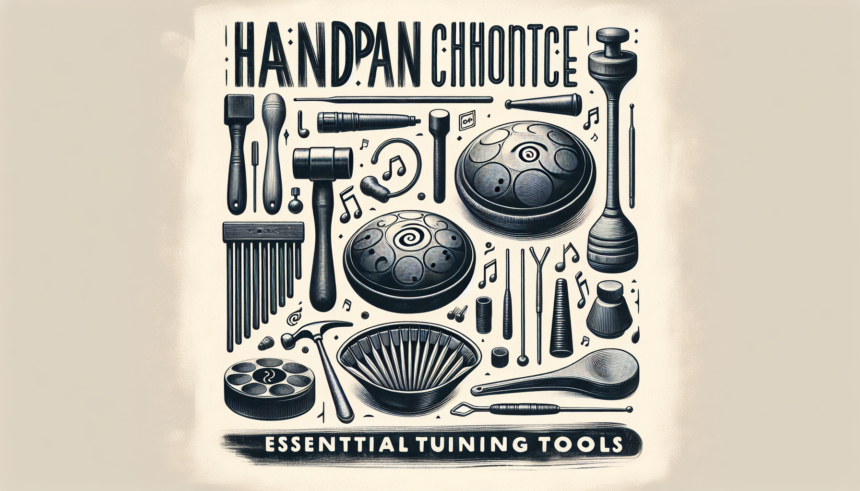Handpan enthusiasts and seasoned musicians alike know that the quality of sound produced by a handpan is crucial. The tonal integrity is maintained through precise tuning, a process that requires various specialized tools. This article explores the essential tuning tools for handpan artists and provides detailed insight into their use. Whether you’re an aspiring handpan artist or a seasoned professional, understanding these tools will elevate your craft.
Importance of Proper Tuning
The handpan, an intricate and harmonically-rich instrument, requires meticulous tuning to maintain its unique sound. Proper tuning ensures the notes are correctly pitched and sustain their resonance. Without it, the distinctive warmth and depth that define handpan music are compromised. The following sections explain the critical tools used in the tuning process and their importance.
Essential Tuning Tools
1. Tuning Hammers
Tuning hammers are arguably the most crucial tool for handpan tuning. These specialized hammers come in various shapes and sizes and are used to adjust the pitch of the note fields on the handpan surface. The hammer’s head can be made from different materials like steel, brass, or even plastic, each providing a distinct impact on the metal’s surface.
When used correctly, tuning hammers can either raise or lower the pitch by altering the metal’s tension. This process requires a high degree of skill and a nuanced understanding of the instrument’s acoustics. It’s not just about striking the metal but understanding where and how to hit it to achieve the desired pitch.
2. Strobe Tuners
A strobe tuner is an essential electronic tool that provides visual feedback on the handpan’s pitch. Unlike traditional tuners, strobe tuners offer unparalleled precision, which is crucial for maintaining the handpan’s intricate tuning. A strobe tuner works by comparing the incoming sound with its internal reference tone and displays the difference, allowing precise adjustments.
For handpan artists, strobe tuners help in identifying minute deviations in pitch that the human ear might not pick up. This accuracy is indispensable when fine-tuning each note field to ensure harmonic coherence across the instrument.
3. Electronic Chromatic Tuners
While strobe tuners offer high precision, electronic chromatic tuners are more user-friendly and accessible. These devices detect the pitch of the handpan’s notes and display it on a digital screen, showing whether the pitch is sharp, flat, or in tune. Chromatic tuners are convenient for quick checks during a tuning session, providing immediate feedback.
Some chromatic tuners also come with built-in microphones or input jacks for direct connection, making them versatile and easy to use. A reliable chromatic tuner is a staple in any handpan artist’s toolkit, ensuring the instrument remains perfectly pitched during practice or performance.
4. Tuning Forks
Tuning forks are traditional tools that produce a specific pitch when struck. Handpan artists use them to set a reference tone, which helps in tuning the handpan’s notes by ear. While electronic tuners provide visual feedback, tuning forks rely on auditory perception, training the ear for subtle pitch variations.
High-quality tuning forks, usually made of steel, offer a consistent and pure tone, serving as a reliable pitch reference. Using tuning forks requires a good ear and experience, making them an essential tool for those who prefer a more hands-on approach to tuning.
5. Beat Frequency Oscillators
Beat frequency oscillators (BFOs) are advanced tools used by some handpan artists to detect phase differences between two sound waves. When the handpan’s note produces a frequency close to the desired pitch, BFOs help in pinpointing the exact deviation, allowing precise adjustments.
BFOs are particularly useful for fine-tuning harmonics and overtones, ensuring that the handpan’s sound is rich and balanced. These devices require a deeper understanding of acoustics and are typically used by experienced tuners for detailed adjustments.
6. Soft Mallets
Soft mallets are used for gentle adjustments and fine tuning. They are ideal for light tapping and nuanced corrections that tuning hammers might be too harsh for. The softer impact ensures that the handpan’s delicate structure is not compromised during the tuning process.
These mallets are typically made from materials like rubber or felt, providing a soft but effective touch. Handpan artists often use them to refine the tuning after making broader adjustments with tuning hammers.
Advanced Tuning Techniques
Microtonal Adjustments
Microtonal adjustments involve fine-tuning notes to pitches that lie between the standard semitones in Western music. This technique is essential for creating handpans with non-standard scales, offering a unique and diverse range of sounds.
Tools like strobe tuners and BFOs are indispensable for microtonal adjustments, providing the precision needed to achieve these subtle pitches. Handpan artists who specialize in microtonal tuning often develop a keen ear for these intricate variations, allowing them to craft truly distinctive instruments.
Harmonic Tuning
Handpans produce not just a fundamental pitch but also harmonic overtones. Ensuring these harmonics are in tune is crucial for maintaining the instrument’s rich, full sound. Harmonic tuning involves adjusting the handpan’s notes to ensure that both the fundamental pitch and its overtones match the desired frequencies.
This process requires a combination of listening skills and the use of advanced tools like BFOs. By focusing on the harmonics, handpan artists can enhance the instrument’s resonance, depth, and overall tonal quality.
Conclusion
Mastering the art of handpan tuning is a blend of skill, experience, and the right tools. From tuning hammers and strobe tuners to tuning forks and beat frequency oscillators, each tool plays a crucial role in achieving the handpan’s desired sound. Proper tuning ensures that the instrument’s unique tonal qualities are preserved, providing listeners with an unforgettable auditory experience.
As handpan music continues to evolve, so too does the technology and techniques used in tuning these remarkable instruments. Handpan artists who invest time in learning and utilizing these essential tuning tools can significantly enhance their craft, producing music that resonates with depth and clarity.
FAQs





